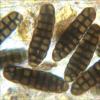
29-03-2025 09:08
 Martine Vandeplanque
Martine Vandeplanque
Bonjour.J’ai essayé d’étudier un Daldinia.Qu

30-03-2025 10:24
Gonzalez Garcia MartaGood morning, I would like to know the opinion of

31-03-2025 17:01
akcay mustafa emreHello everyone, My name is Mustafa Emre Akçay, a

30-03-2025 12:41
Me mandan el material seco de Galicia (España), r

24-03-2025 21:26
Bonjour, J'ai besoin d'une confirmation ou infirm

29-03-2025 06:21
 Francois Guay
Francois Guay
Hi! I found this interesting tiny ascomycete on i

29-03-2025 05:45
Sebastien BassoHello, I'm conducting a mycological inventory in

27-03-2025 22:25
 carl van den broeck
carl van den broeck
On Metzgeria furcata I found hundreds of small whi

Found on cow dung.
Asci: 281x33.73 um; short stalk
Spores: 56.05-61.26x18.71-19.97; 8 transverse septa; spore is clustered and contains 16 cells.

this seems to be a very nice find!
Much more than a Pleospora!
In my opinion this is a species of the genus Pleophragmia.
I only know Pleophragmia leporum Fuckel with one own find from Romania.
But the spores are smaller, only 45-50 x 10-13 µm.
Another species with spores from 55-68 x 15-19 µm is Pleophragmia ontariensis Cain.
You should compare with this!
Maybe tomorrow I can send you the original description of this species.
And if you have some dried material, I'd be very happy to determine!
Best wishes
Norbert


Very nice harvest.
I think Norbert reason for such Pleophragmia. With this size of spores and 9 septa (this is what I get from the photos) it could be actually P.ontariensis. Have you also observed a gelatinous sheath?
Michel.

No Michel I did not observe gelatinous sheaths but I will look for them I am searching for fresh species to send to Norbert. There are that many species but I already found one, need some more for my own herbarium otherwise they will not believe me here.
The spores do indead have 9 septa but the only to see that is with young spores still in the ascus as you observed.
Will those sheaths be more visible in Cotton Blue?
Joop

Michel.

in my opinion the best possibility to make the gelatinous layer visible is to use Indian Ink.
It would be beautiful if you still found a few pseudothecia, Joop!
I'll attach the descriptions of P. leporum and P. ontariensis from Cain: Studies of coprophilous Sphaeriales in Ontario (1934).
Best wishes to you
Norbert

Thanks for the article Norbert.
Pitty that I do'nt have Indian ink.
You asked for some dried species, but how can I dry these little species?
I do have an electrical oven which I used for drying basidiomycetes, but these little ones fall through.
I already have one for you sealed under a deckglass

You can dry the substrate, Joop!
And send it to me!
Norbert "Nobi" Heine

J'avais mal compris ta question; je préfère te répondre en Français. Effectivement comme le dit Norbert l'encre de Chine va bien pour mettre en valeur les envellopes, mais tu peux aussi utiliser le noir de chlorasol ou la nigrosine. Il faut faire des essais suivant les champignons que tu observes; les résultats ne sont pas toujours identiques.
Michel.

I will do that right now and you will also find a lot of Podospora Pyriformis in the substrate.
Joop

J' ai compris votre explication Michel, je faire une nouvelle tentative.
Merci beaucoup.
Joop

if possible, I am also interested in some material of this interesting species to take some photos of it. If not, it will also be ok of course :)
Best wishes,
björn

Up to now I did not find any new species on the other half of the substrate. In total I found 4.

I would be interested, but if there is not enough material, awaiting the observations of Norbert.
thank you
Michel.

Hello Michel,
I have asked the person who collected the dung to look for more substrate from the same spot, if I do have results I will send you a piece and Björn too.
A happy and above all healthy New Year to both of you.
Joop

Michel.

It is without doubt Pleophragmia ontariensis Cain!
I found the ascospores between 58-63 x 17-19 µm.
Congratulations to this beautiful finding!
I picked up only one pseudothecium, but I'm sure, there are still many more.
If you want, Björn, I'll send this piece of substrate to you for further investigations and for better pics!
You can send it finally to Michel! ;-)
Let me add a picture of some ascospores.
Best wishes to all and a good new year!
Norbert

Hello Norbert,
In the article it was mentioned that P. ontariensis has been developed in labratory from horse dung and rabbit dung in Canada, does this mean that the species has never been found in Europe on a totally different substrate in this case cow dung?

Pleophragmia ontariensis is known from Europe with a gathering from Nils Lundqvist done in 1960 on roe deer dung in Närke, a province situated in Svealand in south central Sweden.
Look O.E.Eriksson "The non-lichenized ascomycetes of Sweden".
Or look here: http://www.gbif.se/search/Pleophragmia%20ontariensis/0
I don't know other european findings.
Norbert

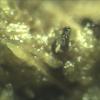
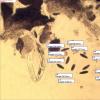
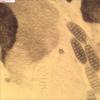
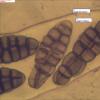
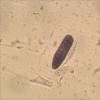
 Pleophragmia-0001.pdf
Pleophragmia-0001.pdf